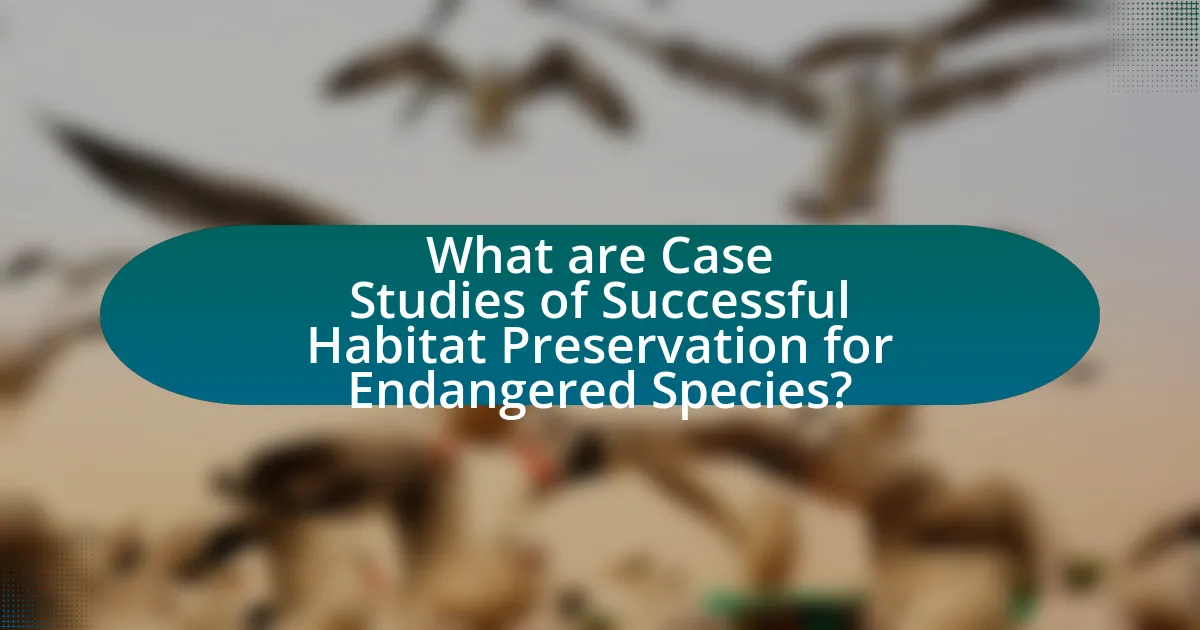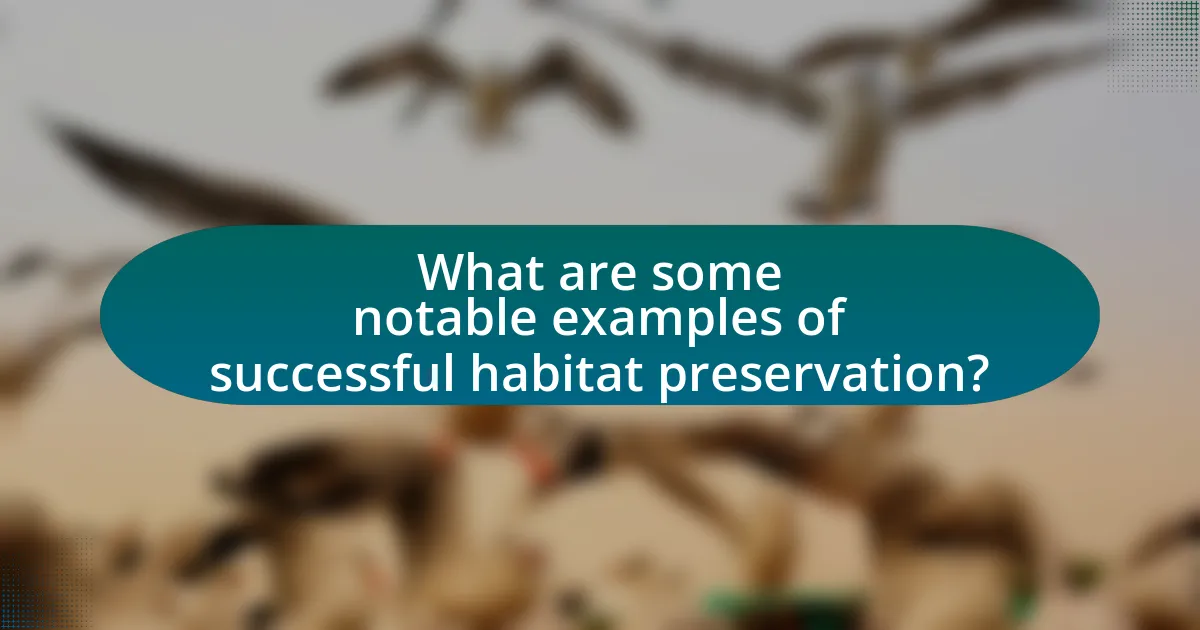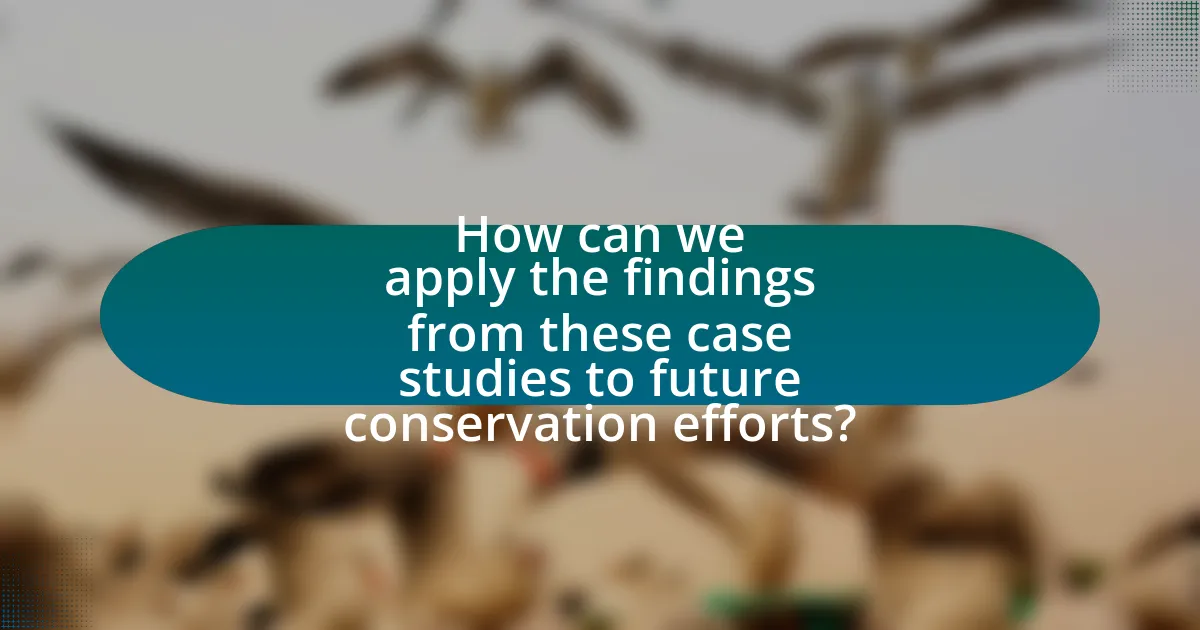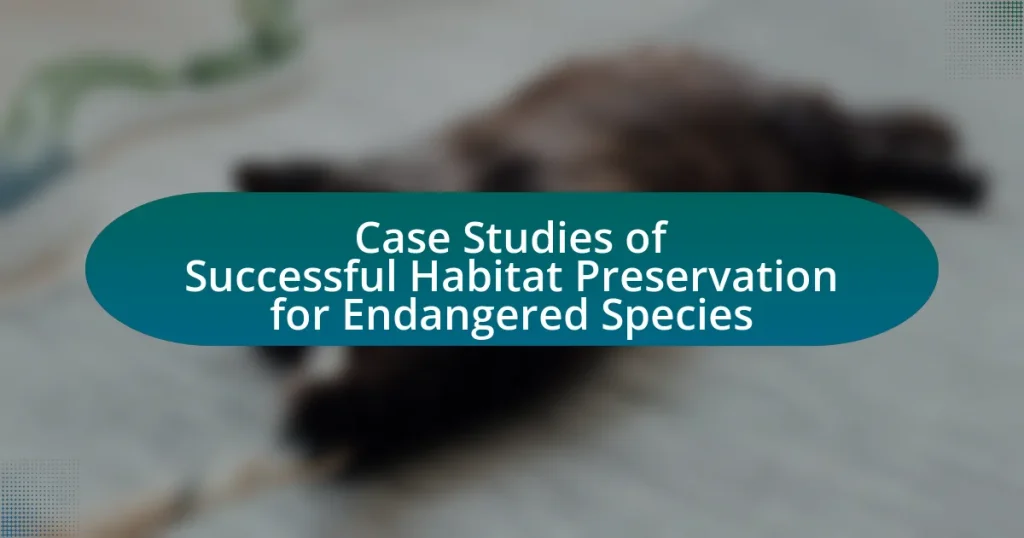The article focuses on case studies of successful habitat preservation for endangered species, highlighting notable examples such as the recovery of the California condor and the Florida panther. It discusses the strategies implemented in these cases, including habitat protection, captive breeding, and community engagement, which have led to significant population increases. The importance of case studies in informing conservation policies and practices is emphasized, along with the metrics used to measure success and the challenges faced in preservation efforts. Additionally, the article outlines best practices and practical steps individuals can take to support habitat preservation initiatives.

What are Case Studies of Successful Habitat Preservation for Endangered Species?
Successful habitat preservation for endangered species includes notable case studies such as the recovery of the California condor and the restoration of the Florida panther’s habitat. The California condor, once on the brink of extinction with only 27 individuals in 1987, has seen its population increase to over 500 due to habitat protection and captive breeding programs. The U.S. Fish and Wildlife Service and various conservation organizations implemented measures to protect nesting sites and reduce lead poisoning from ingested spent ammunition.
Similarly, the Florida panther, which faced habitat loss and genetic bottlenecking, benefited from the establishment of the Big Cypress National Preserve and the Florida Panther National Wildlife Refuge. These areas provide critical habitat and corridors for movement, leading to a population increase from approximately 20 individuals in the 1990s to around 120-230 today. These case studies demonstrate effective strategies in habitat preservation that have led to the recovery of endangered species.
Why are case studies important in habitat preservation efforts?
Case studies are important in habitat preservation efforts because they provide concrete examples of successful strategies and outcomes. These documented instances allow researchers and conservationists to analyze specific methods, understand the challenges faced, and identify best practices that can be replicated in similar contexts. For instance, the recovery of the California condor through targeted habitat management and breeding programs illustrates how detailed case studies can inform future conservation initiatives. By examining the successes and failures of past efforts, stakeholders can make data-driven decisions that enhance the effectiveness of habitat preservation strategies.
What insights can be gained from analyzing successful case studies?
Analyzing successful case studies in habitat preservation for endangered species reveals effective strategies and methodologies that can be replicated. These case studies often highlight the importance of community involvement, demonstrating that local engagement leads to more sustainable outcomes, as seen in the recovery of the California condor through collaborative efforts between conservationists and local stakeholders. Additionally, successful case studies provide data on the ecological impacts of preservation efforts, such as increased biodiversity and improved ecosystem health, which can be quantified through metrics like species population growth and habitat restoration rates. By examining these examples, conservationists can identify best practices, understand challenges faced, and adapt strategies to different contexts, ultimately enhancing the effectiveness of future preservation initiatives.
How do case studies influence policy and conservation strategies?
Case studies influence policy and conservation strategies by providing empirical evidence and practical examples that demonstrate the effectiveness of specific approaches to habitat preservation. For instance, the successful reintroduction of the gray wolf in Yellowstone National Park has informed policies on predator management and ecosystem restoration, showcasing how targeted conservation efforts can lead to biodiversity recovery. Additionally, case studies like the recovery of the California condor highlight the importance of captive breeding and habitat protection, leading to legislative support for similar initiatives. These real-world examples serve as critical tools for policymakers, guiding decisions based on proven outcomes and fostering public support for conservation measures.
What criteria define a successful habitat preservation case study?
A successful habitat preservation case study is defined by measurable ecological outcomes, stakeholder engagement, and long-term sustainability. Measurable ecological outcomes include the recovery of endangered species populations and the restoration of ecosystem functions, which can be quantified through population surveys and biodiversity assessments. Stakeholder engagement involves collaboration with local communities, government agencies, and conservation organizations, ensuring that diverse perspectives are included in the decision-making process. Long-term sustainability is achieved through ongoing monitoring and adaptive management practices, which are essential for addressing changing environmental conditions and ensuring the continued success of preservation efforts. These criteria are supported by various successful case studies, such as the recovery of the California condor, where population increases and habitat protection measures were implemented effectively.
What metrics are used to measure success in these case studies?
Success in case studies of habitat preservation for endangered species is measured using metrics such as population recovery rates, habitat area restored, and biodiversity indices. Population recovery rates indicate the increase in the number of individuals within a species, demonstrating the effectiveness of conservation efforts. Habitat area restored quantifies the amount of land rehabilitated or protected, reflecting the scale of preservation initiatives. Biodiversity indices assess the variety and abundance of species in a given area, providing insights into ecosystem health and resilience. These metrics collectively validate the success of habitat preservation strategies in enhancing the viability of endangered species.
How do stakeholder involvement and community engagement contribute to success?
Stakeholder involvement and community engagement are critical for the success of habitat preservation initiatives for endangered species. Engaging stakeholders, such as local communities, conservation organizations, and government agencies, fosters collaboration and shared responsibility, which enhances the effectiveness of conservation efforts. For instance, the recovery of the California condor involved extensive collaboration among various stakeholders, including the U.S. Fish and Wildlife Service and local tribes, leading to successful breeding programs and habitat restoration. This collaborative approach not only increases resource allocation but also ensures that conservation strategies are culturally relevant and supported by the community, thereby improving long-term sustainability and success rates in preserving endangered species habitats.

What are some notable examples of successful habitat preservation?
Notable examples of successful habitat preservation include the establishment of the Yellowstone to Yukon Conservation Initiative, which protects over 18 million acres of interconnected habitats for wildlife. This initiative has successfully preserved critical migration corridors for species such as grizzly bears and wolves. Another example is the restoration of the Florida Everglades, where efforts have led to the recovery of various species, including the American crocodile, by restoring natural water flow and habitats. Additionally, the creation of marine protected areas, such as the Papahānaumokuākea Marine National Monument in Hawaii, has safeguarded over 582,578 square miles of ocean, benefiting numerous marine species and ecosystems. These examples demonstrate effective strategies in habitat preservation that have led to significant ecological benefits.
How did the Florida Panther recovery serve as a model for habitat preservation?
The Florida Panther recovery served as a model for habitat preservation by demonstrating the effectiveness of targeted conservation strategies and habitat connectivity. The recovery efforts included the establishment of protected areas, such as Big Cypress National Preserve and the Florida Panther National Wildlife Refuge, which provided critical habitats for the species. Additionally, the implementation of wildlife corridors facilitated genetic diversity and movement between isolated populations, which is essential for long-term survival. These strategies have been supported by data showing an increase in the Florida Panther population from approximately 20 individuals in the 1990s to over 120 individuals by 2020, highlighting the success of habitat preservation efforts.
What specific strategies were implemented in the Florida Panther case?
The specific strategies implemented in the Florida Panther case included habitat protection, population monitoring, and genetic management. Habitat protection involved the establishment of the Big Cypress National Preserve and the Florida Panther National Wildlife Refuge, which safeguarded critical areas for the panther’s survival. Population monitoring was conducted through radio collaring and tracking to assess the health and movement patterns of the panther population. Genetic management strategies included introducing Texas cougars to enhance genetic diversity, addressing inbreeding issues that threatened the population’s viability. These strategies collectively contributed to the recovery efforts for the Florida Panther, which is classified as an endangered species.
What were the outcomes of these strategies on the species population?
The outcomes of habitat preservation strategies on species populations have generally been positive, leading to increased numbers and improved health of various endangered species. For instance, the recovery of the California condor population, which rose from 27 individuals in 1987 to over 500 in 2021 due to habitat protection and breeding programs, exemplifies the effectiveness of these strategies. Similarly, the reintroduction of wolves in Yellowstone National Park has resulted in a balanced ecosystem, benefiting multiple species and enhancing biodiversity. These examples demonstrate that targeted habitat preservation efforts can significantly bolster endangered species populations.
What lessons can be learned from the restoration of the California Condor?
The restoration of the California Condor teaches critical lessons about the importance of captive breeding, habitat protection, and public awareness in conservation efforts. Captive breeding programs, initiated in the 1980s when the population dwindled to just 27 individuals, successfully increased the population to over 500 birds by 2021, demonstrating the effectiveness of this strategy. Additionally, habitat protection is essential; the California Condor’s recovery involved safeguarding its natural environment in California, Arizona, and Utah, which is crucial for its survival. Public awareness campaigns have also played a significant role, as they foster community support and involvement in conservation initiatives, highlighting the necessity of engaging the public in protecting endangered species.
What challenges were faced during the California Condor recovery efforts?
The California Condor recovery efforts faced significant challenges, including habitat loss, lead poisoning, and low genetic diversity. Habitat loss resulted from urban development and agricultural expansion, which reduced the available space for the condors to thrive. Lead poisoning, primarily from ingesting spent lead ammunition, was a major cause of mortality, leading to the implementation of lead-free ammunition initiatives. Additionally, the small population size created issues with inbreeding, which threatened the species’ long-term viability. These challenges necessitated comprehensive management strategies, including captive breeding programs and habitat protection measures, to ensure the survival of the California Condor.
How did collaboration among organizations impact the success of the California Condor project?
Collaboration among organizations significantly enhanced the success of the California Condor project by pooling resources, expertise, and funding. Various entities, including government agencies, non-profit organizations, and academic institutions, worked together to implement a comprehensive recovery plan that included captive breeding, habitat protection, and public education initiatives. For instance, the U.S. Fish and Wildlife Service partnered with the Los Angeles Zoo and the San Diego Zoo to establish a breeding program that successfully increased the condor population from just 27 individuals in 1987 to over 500 by 2021. This collaborative effort not only facilitated the sharing of best practices but also ensured a coordinated approach to monitoring and managing the species, ultimately leading to the California Condor’s gradual recovery and reintroduction into the wild.

How can we apply the findings from these case studies to future conservation efforts?
The findings from case studies of successful habitat preservation for endangered species can be applied to future conservation efforts by implementing targeted strategies that have proven effective in similar contexts. For instance, the case study of the California condor recovery program demonstrates that captive breeding combined with habitat restoration can significantly increase population numbers. This approach can be replicated for other endangered species facing habitat loss. Additionally, the use of community engagement, as seen in the restoration of the Atlantic Forest in Brazil, highlights the importance of involving local populations in conservation efforts, which can lead to sustainable practices and increased awareness. These examples provide a framework for future initiatives, emphasizing the need for adaptive management, stakeholder collaboration, and evidence-based practices to enhance conservation outcomes.
What best practices can be derived from successful habitat preservation case studies?
Best practices derived from successful habitat preservation case studies include community involvement, adaptive management, and scientific research integration. Community involvement ensures local stakeholders are engaged, fostering stewardship and support for conservation efforts, as seen in the successful restoration of the Florida Everglades, where local communities played a crucial role in decision-making processes. Adaptive management allows for ongoing assessment and modification of strategies based on ecological feedback, exemplified by the Yellowstone National Park wolf reintroduction, which adjusted management practices based on observed ecological changes. Lastly, integrating scientific research into conservation strategies, as demonstrated in the recovery of the California condor, provides data-driven insights that enhance the effectiveness of habitat preservation efforts. These practices collectively contribute to the sustainability and success of habitat preservation initiatives.
How can adaptive management strategies enhance future conservation projects?
Adaptive management strategies can enhance future conservation projects by allowing for iterative learning and flexibility in response to changing environmental conditions. These strategies involve monitoring ecological outcomes, assessing the effectiveness of management actions, and adjusting practices based on observed results. For instance, a study on the adaptive management of the Florida Everglades demonstrated that ongoing data collection and analysis led to improved water management practices, which significantly benefited the habitat of endangered species like the American crocodile. This evidence shows that adaptive management not only fosters resilience in conservation efforts but also increases the likelihood of achieving long-term ecological goals.
What role does ongoing research play in improving habitat preservation efforts?
Ongoing research plays a critical role in improving habitat preservation efforts by providing data-driven insights that inform conservation strategies. For instance, studies on species population dynamics and habitat requirements enable conservationists to identify key areas for protection and restoration. Research conducted by the National Oceanic and Atmospheric Administration (NOAA) has shown that understanding the ecological needs of endangered species, such as the California condor, directly influences habitat management practices, leading to increased survival rates. Additionally, ongoing research helps to monitor the effectiveness of preservation efforts, allowing for adaptive management based on real-time data, which is essential for responding to environmental changes and threats.
What are the common challenges faced in habitat preservation initiatives?
Common challenges faced in habitat preservation initiatives include funding limitations, regulatory hurdles, and stakeholder conflicts. Funding limitations often restrict the scope and duration of preservation projects, making it difficult to implement comprehensive conservation strategies. Regulatory hurdles can arise from complex legal frameworks that complicate land use and conservation efforts, leading to delays and increased costs. Additionally, stakeholder conflicts, such as disagreements between local communities, government agencies, and conservation organizations, can hinder collaboration and effective decision-making. These challenges are documented in various studies, including the “State of the World’s Protected Areas” report by the International Union for Conservation of Nature, which highlights the need for adequate resources and stakeholder engagement in successful habitat preservation efforts.
How can funding and resource allocation impact the success of preservation efforts?
Funding and resource allocation significantly impact the success of preservation efforts by determining the availability of necessary financial and material support for conservation projects. Adequate funding allows for the implementation of effective management strategies, habitat restoration, and monitoring programs essential for the survival of endangered species. For instance, a study by the World Wildlife Fund found that projects with robust financial backing were 50% more likely to achieve their conservation goals compared to those with limited resources. Additionally, strategic allocation of resources ensures that critical areas receive attention, enabling targeted interventions that can lead to measurable improvements in biodiversity and ecosystem health.
What strategies can be employed to overcome political and social barriers?
To overcome political and social barriers in habitat preservation for endangered species, strategies such as stakeholder engagement, policy advocacy, and community education can be employed. Stakeholder engagement involves collaborating with local communities, government agencies, and NGOs to build consensus and support for conservation initiatives. Policy advocacy focuses on influencing legislation and regulations that protect habitats, ensuring that legal frameworks are in place to facilitate preservation efforts. Community education raises awareness about the importance of biodiversity and the role of endangered species, fostering a sense of ownership and responsibility among local populations. These strategies have been effective in various case studies, such as the recovery of the California condor, where collaboration among stakeholders led to successful breeding and reintroduction programs.
What practical steps can individuals take to support habitat preservation for endangered species?
Individuals can support habitat preservation for endangered species by participating in local conservation efforts, such as volunteering with organizations focused on habitat restoration. Engaging in community clean-up events helps remove pollutants that threaten ecosystems. Additionally, individuals can advocate for policies that protect natural habitats by contacting local representatives and supporting legislation aimed at conservation. Financial contributions to reputable wildlife organizations also provide essential funding for habitat preservation projects. According to the World Wildlife Fund, community involvement in conservation initiatives has proven effective in maintaining biodiversity and protecting endangered species’ habitats.


